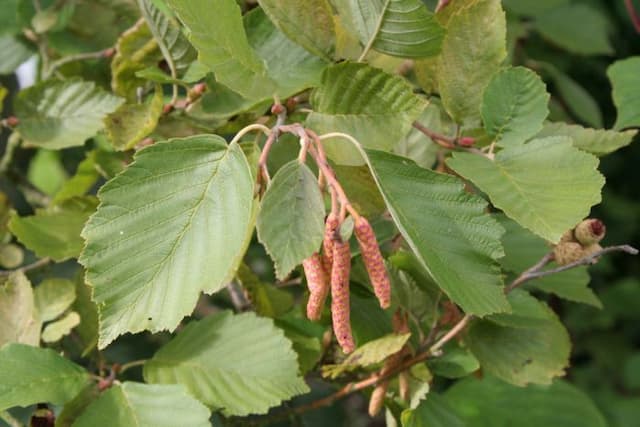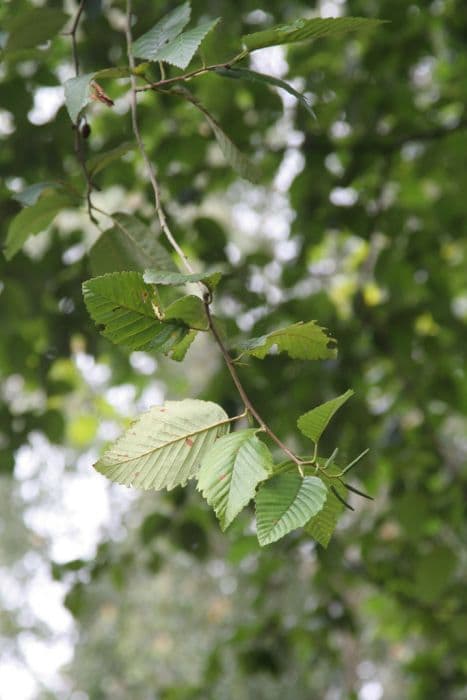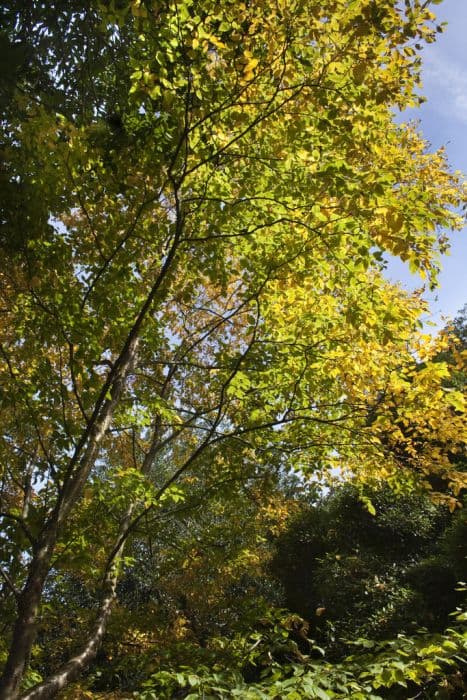Fang's Hornbeam Carpinus fangiana

ABOUT
The plant known as the Chinese Hornbeam showcases a deciduous nature with an attractive, rounded to broadly columnar growth habit. Its leaves are elegantly toothed, oval to lance-shaped, with a lustrous dark green color turning a delightful assortment of yellows, oranges, and reds in the fall, making for a striking autumn display. The textured, grey bark, and the sinewy trunk add to its ornamental value throughout the year. In spring to early summer, you'll notice the Chinese Hornbeam producing pendulous clusters of flowers. These chains of flowers, reminiscent of little hop-like fruiting catkins, remain attractive as they develop through the season. In addition to its foliage and flowering appeal, this plant is often noted for its winter silhouette, with a branching pattern that stands out once the leaves have fallen. Refreshing and lush during the growing season, and with a pleasing structure during dormancy, the Chinese Hornbeam remains an elegant choice year-round for any garden that doesn't rely on the sheer size of plants to make an impact.
About this plant
 Names
NamesFamily
Betulaceae
Synonyms
Fang's Hornbeam
Common names
Carpinus fangiana
 Toxicity
ToxicityTo humans
Carpinus fangiana, commonly known as Fang's hornbeam, has no widely recognized toxicity to humans. There is a lack of substantial evidence indicating that this plant, if ingested, poses a health risk to people. As with any plant, individual allergies or sensitivities may exist, and care should always be taken when handling unknown plants. However, the general consensus is that Fang's hornbeam does not contain compounds known to be poisonous to humans.
To pets
Similar to its effects on humans, Carpinus fangiana, or Fang's hornbeam, is not commonly known to be toxic to pets. There's a lack of information suggesting that the ingestion of parts of this plant could lead to poisoning in animals such as dogs and cats. As with any plant material, ingestion could potentially cause mild stomach upset due to the animal's digestive system not being accustomed to processing plant fibers, but no specific toxic effects are widely reported or recognized. Always monitor pets around plants and consult a veterinarian if you suspect they have ingested questionable plant material.
 Characteristics
CharacteristicsLife cycle
Perennials
Foliage type
Deciduous
Color of leaves
Varies
Height
20-30 feet (6-9 meters)
Spread
20-30 feet (6-9 meters)
Plant type
Tree
Hardiness zones
6
Native area
China
Benefits
 General Benefits
General Benefits- Ornamental Value: Carpinus fangiana, commonly known as Fang's hornbeam, is valued for its decorative foliage and attractive form, making it a popular choice for landscape design.
- Shade Provider: With its broad canopy, Fang's hornbeam offers shade and can help in reducing temperatures in its immediate surroundings.
- Erosion Control: The root system of Fang's hornbeam helps in stabilizing soil and thereby aids in preventing erosion on slopes and banks.
- Habitat Supporting: It provides a natural habitat and food source for various bird species and other wildlife.
- Seasonal Interest: This plant features seasonal changes that are visually interesting, with foliage turning various colors in autumn.
- Durable Wood: The wood of Fang's hornbeam is hard and durable, suitable for making tool handles and other wooden items requiring resilience.
 Medical Properties
Medical PropertiesThis plant is not used for medical purposes.
 Air-purifying Qualities
Air-purifying QualitiesThis plant is not specifically known for air purifying qualities.
 Other Uses
Other Uses- Carpinus fangiana, commonly known as the Chinese hornbeam, can be used in furniture making due to its strong, hard wood, which makes for durable furnishings.
- The wood of the Chinese hornbeam is also suitable for crafting musical instruments, providing a rich resonance and aesthetic appeal.
- The tree's dense canopy offers shade in urban landscapes and is ideal for planting in parks and along streets.
- The tree can be used as a windbreak feature in landscaping, breaking the force of wind in more exposed areas.
- Chinese hornbeam is suitable for bonsai cultivation, allowing enthusiasts to shape and display the miniature forms of this attractive tree.
- The tree’s wood can be used to make veneer, a decorative, high-quality finish for various woodworking projects.
- Sawdust from the Chinese hornbeam can be used as mulch in gardens, providing weed control and soil moisture retention.
- The leaves of the tree can be composted to enrich the soil with nutrients as they decompose, making it an eco-friendly fertilizer option.
- Fallen leaves and twigs from Carpinus fangiana can be collected and used as bedding for livestock, offering a soft and absorbent material.
- The tree’s dense wood can be turned into quality charcoal for cooking or artistic uses, such as drawing and sketching.
Interesting Facts
 Feng Shui
Feng ShuiThe plant Carpinus fangiana, commonly known as Chinese Hornbeam, is not used in Feng Shui practice.
 Zodiac Sign Compitability
Zodiac Sign CompitabilityThe Chinese Hornbeam is not used in astrology practice.
 Plant Symbolism
Plant Symbolism- Strength and Resilience: Carpinus fangiana, commonly known as Fang's Hornbeam, is from the genus Carpinus, which is often associated with strength and resilience. Hornbeams are known for their tough wood, often used in making tools and yokes, symbolizing the ability to bear burdens and withstand the test of time.
- Flexibility: Despite their hard wood, hornbeams such as the Fang's Hornbeam can bend without breaking. This trait symbolizes flexibility and adaptability in life, suggesting that one can endure challenges while still being able to bend when necessary.
- Growth and Renewal: As a deciduous tree, Fang's Hornbeam exhibits seasonal changes, shedding its leaves in autumn and growing new ones in spring. This cycle symbolizes growth, renewal, and the idea of new beginnings.
- Longevity: Fang's Hornbeam can live for a considerable time, symbolizing longevity and continuity. The plant's long life span represents wisdom gained over years and the passage of knowledge through generations.
 Water
WaterThe Chinese Hornbeam, which is the common name of Carpinus fangiana, should be watered deeply but infrequently to mimic its natural woodland habitat. This tree prefers moist, well-drained soil, so when the top 2-3 inches of soil feels dry to the touch, it’s time to water again. Depending on the climate and weather conditions, this may translate to about once a week, give or take a few days. It's recommended to apply about 1-2 gallons of water for each inch of trunk diameter every time you water. Ensure that the water penetrates deeply into the soil to encourage strong root growth rather than just wetting the surface.
 Light
LightThe Chinese Hornbeam flourishes best in full sun to partial shade. It should be planted in a location where it can receive at least 4-6 hours of direct sunlight each day, with filtered sunlight for the remainder. Avoid placing it in deep shade, as this would compromise its growth and foliage quality.
 Temperature
TemperatureThe Chinese Hornbeam is hardy in a range of temperatures and can withstand winters, surviving temperatures as low as -20°F. However, it thrives best in an environment where average temperatures are between 60°F and 80°F. Extreme heat above 100°F should be avoided, as it can cause stress to the plant.
 Pruning
PruningPruning the Chinese Hornbeam is mainly done for aesthetic shaping and to remove any dead or diseased branches. The best time to prune is late winter or early spring before new growth starts. Annual light pruning is often adequate to maintain its desired shape and promote healthy growth. Thinning the canopy to allow light and air circulation can also be beneficial; this helps to reduce the risk of disease.
 Cleaning
CleaningAs needed
 Soil
SoilThe Chinese Hornbeam thrives in well-draining soil that is rich in organic matter. A mix of loam, peat, and coarse sand or perlite, at ratios of 2:1:1 respectively, is ideal. The soil pH should range between 5.5 and 7.5 to ensure the best growth.
 Repotting
RepottingThe Chinese Hornbeam, as a slow-growing tree, does not require frequent repotting. Young trees benefit from repotting every 2-3 years, while mature specimens can be repotted less often, every 4-5 years, to replenish soil nutrients.
 Humidity & Misting
Humidity & MistingThe Chinese Hornbeam prefers moderate to high humidity levels. Maintaining a humidity level of around 50-60% is optimal for this plant to replicate its natural habitat and ensure healthy growth.
 Suitable locations
Suitable locationsIndoor
Provide bright indirect light and moderate humidity for Chinese Hornbeam.
Outdoor
Plant in well-draining soil, partial shade to full sun for Chinese Hornbeam.
Hardiness zone
6b-9a USDA
 Life cycle
Life cycleCarpinus fangiana, commonly known as Fang's hornbeam, begins its life cycle as a seed that germinates in moist, well-drained soil, typically in the presence of sufficient light. Seedlings emerge with characteristic heart-shaped leaves, quickly establishing a root system and beginning the vegetative growth phase. As the plant matures, it develops a woody stem and a broad, rounded canopy through a juvenile phase that can last several years. Once mature, Fang's hornbeam enters the reproductive phase, producing male and female flowers on the same tree (monoecious), with the male catkins being pendulous and the female inflorescences more upright. After pollination, typically by wind, the female flowers develop into small, nut-like fruits enclosed in a leafy bract, which are dispersed by gravity or animals, completing the reproductive cycle. The mature tree can live for many decades, with the cycle repeating annually when conditions are favorable.
 Propogation
PropogationPropogation time
Spring-early summer
The Chinese Hornbeam, or Carpinus fangiana, can be propagated using its seeds. The best time to sow the seeds is in the late fall to early winter, following their maturation. Seeds should be cold stratified for about 1-3 months at 34-40 degrees Fahrenheit (1-4 Celsius) to break seed dormancy and promote germination. After stratification, sow the seeds in a well-drained seed starting mix, lightly covering them with soil. Keep the soil moist but not waterlogged, and provide light and warmth. Germination may take several weeks, and once the seedlings are sturdy enough, they can be transplanted to individual pots or direct locations in the garden where they will continue to grow.









